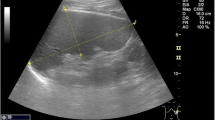Summary and Conclusion
Esophagogastroscopy, splenic-pulp manometry, and splenoportography were combined in a prospective study of 60 patients with documented liver disease and suspected portal hypertension. All three procedures were performed on each of the patients within a 6-day period. Twenty patients were actively bleeding at the time of endoscopic examination.
Esophagogastroscopy demonstrated varices in 90% of the patients studied. Splenoportography, however, demonstrated collateral circulation in only 50% of the patients with endoscopically demonstrated varices. In no instance did splenoportography demonstrate collateral circulation not previously seen on endoscopy. Splenoportography failed to demonstrate collateral circulation in all patients whose splenic-pulp pressure was less than 270 mm. water.
In 20 patients with upper gastrointestinal bleeding, the height of the splenic-pulp pressure was a poor index of the site of bleeding. Eight patients with portal hypertension and esophageal varices were found to be bleeding from nonvariceal sites. Conversely, 5 patients with active bleeding from endoscopically demonstrated varices had no collateral circulation revealed by splenoportography.
It is evident from this study that splenic-pulp manometry, splenoportography, and esophagogastroscopy will frequently yield divergent results in the evaluation of portal hypertension and portosystemic collateral circulation in patients with liver disease. While splenoportography may be useful in determining the patency of the portal vein and demonstrating large spontaneous or surgical portosystemic shunts, esophagogastroscopy is a better method for detecting esophageal varices and determining whether they are bleeding. The height of the splenic-pulp pressure is of little value in indicating the site of upper gastrointestinal bleeding.
Similar content being viewed by others
References
de Castro Silva, L., Goffi, F., Schmidt, L., andSao Thiago, J. B. Efficacy of esophagography, esophagoscopy, and splenoportal venography in the diagnosis of esophageal varices.Rev. paulista med. 64:10, 1964.
Jackson, F. C. “Directional” flow patterns in portal hypertension.Arch. Surg. 87:307, 1963.
Palmer, E. D. On the natural history of esophageal varices which are secondary to portal cirrhosis.Ann. Int. Med. 47:18, 1957.
Bennett, H. D., Lorentgen, C, andBauer, C. A. Transient esophageal varices in hepatic cirrhosis.Arch. Int. Med. 92:507, 1953.
Palmer, E. D. The problem of unexplainable esophageal varices.South. M. J. 56: 1317, 1963.
Evans, K. T. Oesophageal and gastric varices.Brit. J. Radiol. 32:233, 1959.
Leevy, C. M., Cherrick, G. R., andDavidson, C. S. Portal hypertension.New England J. Med. 262:397, 1960.
Panke, W. F., Moreno, A. H., andRousselot, L. M. The diagnostic study of the portal venous system.Med. Clinics North America 44:727, 1960.
Turner, M. D., Sherlock, S., andSteiner, R. E. Splenic venography and intrasplenic pressure measurement in the clinical investigation of the portal venous system.Am. J. Med. 23:846, 1957.
Zeid, S. S., Felson, B., andSchiff, L. Percutaneous splenoportal venography with additional comments on transhepatic venography.Ann. Int. Med. 52:782, 1960.
Castro, M. R. The value of splenic pulp manometry and splenoportography in the diagnosis of bleeding esophageal varices.Acta medica phillipina 19:91, 1962.
Doppman, J. L., andShapiro, R. L. Bleeding esophageal varices in presence of a normal splenoportogram.Am. J. Roentgenol. 86:1103, 1961.
Schaefer, J., Brauschireiber, J., Mistilis, S., andSchiff, L. Gastroesophageal variceal bleeding in the absence of hepatic cirrhosis or portal hypertension.Gastroenterology 46:583, 1964.
Bercstrand, I., andEkman, C. A. Percutaneous lieno portal venography.Acta radiol. 47:269, 1957.
Bergstrand, I., andEkman, C. A. Portal circulation in portal hypertension.Acta radiol. 47:1, 1957.
Palmer, E. D. On the correlation between portal venous pressure and the size and extent of esophageal varices in portal cirrhosis.Ann. Surg. 138:741, 1953.
Atkinson, M., andSherlock, S. Intrasplenic pressure as an index of portal pressure.Lancet 1:1325, 1954.
Rousselot, L. M., andBurchell, A. R. “Portal Venography and Manometry.” InDiseases of the Liver. L. Schiff, Ed. 2nd. ed., pp. 284–328. Lippincott, Philadelphia, 1963.
Katz, D., Douvres, P., Weisberg, H., Charm, R., andMcKinnon, W. Sources of bleeding in upper gastrointestinal hemorrhage: A re-evaluation.Am. J. Digest. Dis. 9:447, 1964.
Author information
Authors and Affiliations
Additional information
Supported in part by Graduate Training Grant TI-AM-5237 and Clinical Research Center Grant AM-05576-02 from the National Institute of Arthritis and Metabolic Diseases, N.I.H., U. S. Public Health Service, and Contract U 1373 of the Health Research Council of the City of New York.
Rights and permissions
About this article
Cite this article
Greene, L., Weisberg, H., Rosenthal, W.S. et al. Evaluation of esophageal varices in liver disease by splenic-pulp manometry, splenoportography, and esophagogastroscopy. Digest Dis Sci 10, 284–292 (1965). https://doi.org/10.1007/BF02233419
Issue Date:
DOI: https://doi.org/10.1007/BF02233419




